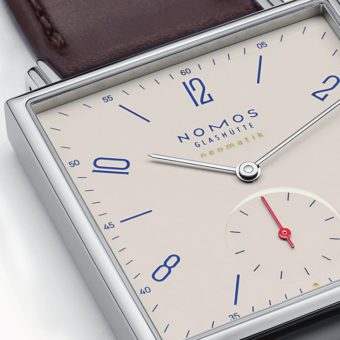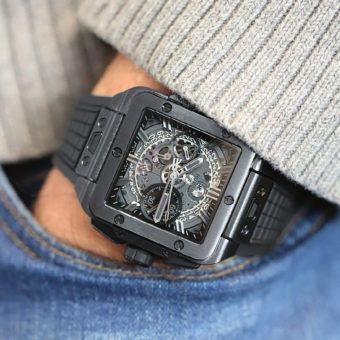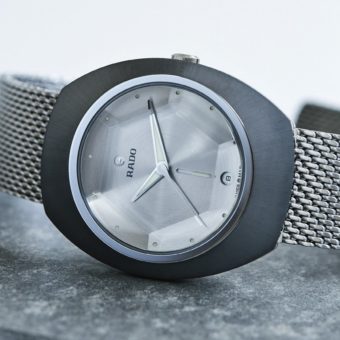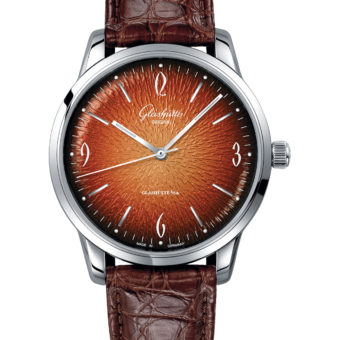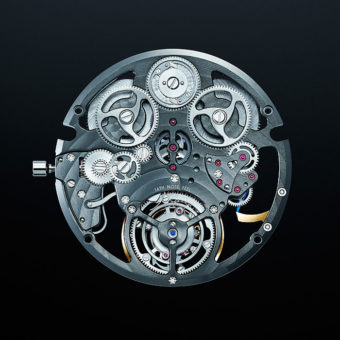
In 1999, Richard Mille left his position as CEO of the Mauboussin watch and jewelry house to launch his own watch brand. His first model, the groundbreaking RM 001 — with its ultramodern design and technically fascinating movement made by Renaud et Papi — set the stage for the line, which has since become one of the leading “artisan” watch brands on the market.
Richard Mille watches are characterized by their futuristic styling inspired by Formula 1 racecars — a passion of its founder— and their use of modern, sometimes exotic materials in its movements, most of which are equipped with tourbillons. For many watch aficionados, the ones who covet RM watches despite high prices and long delivery times, the brand has changed the perceptions of what a mechanical watch should look and feel like on the wrist. I sat down with Mr. Mille for a wide-ranging conversation on his products, his philosophy, and the watch industry in general. He has passionate opinions on all three, and is not afraid to share them. What follows are the highlights.
WT: Your training is in business rather than watchmaking. At what point did you want to design your own watch?
RM: In my career, I had become fed up with marketing obligations. I realized that the only way to do what I wanted to do was to launch my own brand, with no limits or constraints other than technical ones. The paradox I saw was that many watchmakers were giving themselves limits: their only dream was to do replicas of 18th- or 19th-century watches. Today, watches are made by machines, so I said to myself that if we have to use machines, let’s do contemporary watches. Yet I also wanted to use the best of the watch culture, which is to say, a lot of hand craftsmanship. I never wanted to impose a price limit on my developments; the prices are the results of my choices. I don’t give a damn if a movement takes four months to be assembled, because I’m not obsessed by volume. I release the 20 or 30 pieces, and of course they are very expensive.
WT: You had faith that no matter what they cost, the watches you were going to make would find an audience?
RM: I was sure I would sell a few dozen pieces; I didn’t know that the public would demand a few thousand, and more! Even with everyone talking about a financial crisis, I am up 17% from last year at this time. Three years ago I did 1,500 pieces. Last year I did a few more than 2,000. This year I might do 2,300 or 2,500. In the long run my objective is to do between 3,000-4,000 pieces, probably not more than that.
WT: Which interest came first for you — auto racing, aviation, or watches?
RM: Racecars are already influenced greatly by aeronautics, in the areas of materials and aerodynamics. In making watches, as with both cars and planes, you have the same problem of transmission of power. You have the same problem of rigidity. You have the same problem of shock resistance. In a car or an aircraft, you must solve those problems and that is exactly what I tried to do in my watches. I love watch culture, car culture, aircraft culture, space culture… but I am not prisoner to any of them. With my watches, the goal is a synthesis of all of these.
WT: Was there a moment when you were looking at cars and airplanes and realized that you, as someone in the watch business, could apply these techniques?
RM: Yes, but it was long before I launched my brand. I was always amazed, for example, that people in the watch business were still using brass in movement plates. Brass is not a very rigid material. I’ve seen that the baseplate has a tendency to twist, which is a problem when you have wheels with the tolerance of a micron. This is why I chose titanium [for my baseplates] — not because it was a sexy or new material but because it’s extremely rigid. I also used carbon nanofibers: it’s an amorphous material that can last for hundreds of years without moving one micron, so it’s ideal.
WT: Were you one of the first to use titanium inside a watch?
RM: I was the first to use it for the baseplates, yes. I was also the first to use carbon nanofibers.
WT: And you see both of these materials everywhere now.
RM: Yes, but in the cases, not the movements. Almost nobody uses titanium for base plates, or even carbon nanofibers. Audemars Piguet [which also uses movements from Renaud et Papi] is the only other company that does it, and I’ll tell you why. One, because it costs a fortune; two, because the manufacturing is very, very difficult. For the titanium baseplates I need, I have more than a 70% rejection rate. Some companies are using carbon Kevlar, which is very cheap; it is a tissue of carbon fiber with epoxy resin. It has nothing to do with carbon nanofibers, which are much more expensive. Carbon nanofibers are used on Formula 1 racecar brakes and space shuttles.
WT: Many watch companies market themselves as “traditional.” While you are certainly using traditional mechanical watchmaking methods, you emphasize the modernity, not shying away from the fact that you’re using modern, high-tech machines in the process. Do you feel you’ve influenced other brands to adopt this approach?
RM: I think so. I emphasize the modernity, but at the same time I respect the culture. All my models are hand-finished. Many companies make 18th-century types of watches, but manufactured by machines and finished by machines. My level of rejection is between 35 to 40 percent of the finished products. Finishing by hand makes the process much riskier.
WT: Your brand has become very associated with the tonneau-shaped case. Is there something about this shape that appeals to you specifically?
RM: Not really. Originally, I wanted to do a rectangular model. But to fit all the devices inside, I had to enlarge it into a tonneau. In my first drawing of the RM-001, the watch was rectangular.
Richard Mille’s first watch, the RM 001

WT: Did ergonomics also play a role in the design?
RM: From the beginning. I am crazy about ergonomics. People who buy my watches wear them because they are very comfortable. My new diver’s watch, the RM-025, is a big beast, but a beast that fits very, very well on the wrist. I push my people to the limit on this. It’s very difficult to make a watch ergonomic, but I fight like mad to do so, including with the crowns. We’ve all had watches that made you want to kill the designer because winding them was a nightmare. I’ve also fought against this marketing concept of “perceived value” — the idea that the watch must weigh a lot to have a value. To me, that’s nonsense. In fact, it costs much more to manufacture a watch in titanium than the same one in gold. It’s very difficult to work with titanium. When I came out with watches in titanium that were as expensive as a gold piece, people said I was crazy. But a lot of customers appreciated that it was very comfortable. Now it is accepted that a light watch can cost as much as a heavy watch. After all, who is going to say, “My car weighs five tons, so it should cost more than a car that weighs one ton?” Everybody is fighting against weight today. And to fight against weight costs a fortune.
The RM 025: a “beast” engineered for wrist comfort

WT: You’ve also not expressed a great interest in making a movement from scratch.
RM: Well, the truth is that most of the so-called manufactures are, in fact, assemblers. They buy their parts from here and from there. The other day I was at the Vaucher factory in Fleurier, and I saw bridges being made for a brand that I will not name that everybody says is a manufacture. My philosophy is that I don’t pretend to do everything myself. Nobody is doing everything from scratch because everybody is chasing down balance wheels here, springs and bridges there, and then they assemble them. When you visit most of these companies, where do you see the big machines that [make these parts]? Nowhere. So it’s a big lie.
WT: Do you believe the word manufacture gets thrown around more often then it should in the watch business?
RM: Exactly. And I am lucky enough to work with by far the best true manufacture in the world, which is Renaud et Papi. I work with them from the beginning through the finished watch. When they did the RM 001, nothing like it existed in the market. It was the first time in watch history that a watch was made with a baseplate composed only of tubes. They all had to be adjusted, vertically and horizontally perfect, so the wheels would work with the turbines in this construction. This was an incredible challenge. It was all from scratch. And when you start a piece like that, you don’t always know when you’ll finish.
WT: So it starts with your idea and Renaud et Papi makes it a reality?
RM: Exactly. It’s like with Formula 1: you always deal with the best professionals. I have the best crown maker in the world. I have the best sapphire crystal maker in the world. I have the best people making dials. Because I don’t care about the cost. Collectors understand that. I am not ashamed to say that from the beginning I have worked with Renaud et Papi. But I was the one who came to them, saying, I want this, this, and this.
WT: Richard Mille watches are among the more “masculine”-looking watch lines out there. What made you decide to release ladies’ models like the RM 019 Celtic Knot tourbillon watch?
RM: From the business point of view, I wanted to control my company’s growth. The extreme pieces I’m doing with Renaud et Papi are very limited in volume. They cannot deliver more than about 300 pieces a year. Also, I do not want to be a prisoner to only one style. As with the RM 001, I wanted the tourbillon to represent only about 20 percent of what makes the watch interesting. Today, the tourbillon alone isn’t that interesting to anybody. People buy a tourbillon watch from me because I give them something else. They will buy this piece, the ladies watch, not simply because it’s a tourbillon but because it’s beautiful: the base plate is in onyx. Look at the engraving on the back. The decoration in three dimensions is also a masterpiece. On the watch I did for Boucheron [the RM 018], it’s the same. The tourbillon device is exotic, but [the most interesting features are] the wheels, which for the first time in watch history are made from precious stones. This one will be only 30 pieces, each one unique from the others.
For the ladies: RM 019 features a tourbillon, a black onyx baseplate and a diamond-studded “Celtic knot” dial design.

Made exclusively for the 150th anniversary of famed Paris jeweler Boucheron, the limited-edition RM 018 has a white gold case and wheels made from precious stones.

WT: Speaking of special projects, what motivated you, with such an ultra-modern brand, to create something as “retro” as the RM 020 tourbillon pocket watch?
RM: Because I was fed up to here that the pocket-watch was regarded as dead. I think it is very limiting to think that only wristwatches can be considered watches. Originally, all watches were pocket watches. So, again, I want to pay tribute to the watch culture, but in a modern way.
WT: You figured you were the one to bring the pocket watch into the 21st century?
RM: Exactly. I am the one who gives the kiss to sleeping beauty! [laughs] And it’s a magnificent piece. I could have done a pocket watch like your grandfather’s pocket watch, but nobody is interested in that. I think if the high-end watch business carries on like it has, it will become so boring that it will die. I am sincere when I say that. We must be open to the worlds of art, architecture, lifestyle… open to new concepts. A tourbillon or a minute repeater doesn’t really have any relevance to anybody today. As I said, I respect the watch culture. But to use the machinery of today to make 18th century watches, it’s like if you were in the automobile industry and using the technology to make replicas of the Ford Model T. [As a collector,] you’re better off going to an auction and buying a real one from the 19th or early 20th century. It’s very important to approach it as if you were in the arts. When the Cubists came, it was a rupture with existing culture, but at the same time it didn’t neglect the past.
WT: I also just realized that since this model is a pocket watch, and not worn on the wrist, the Tourbillon actually serves a function — which it does not do in a wristwatch.
RM: Yes. We have come back to the original purpose of the tourbillon!
Richard Mille’s RM 020 tourbillon pocket watch, with its square titanium case and detachable chain, is a modern interpretation of a vintage timepiece.

The RM 020’s two big barrels provide the watch approximately 10 days of power.


